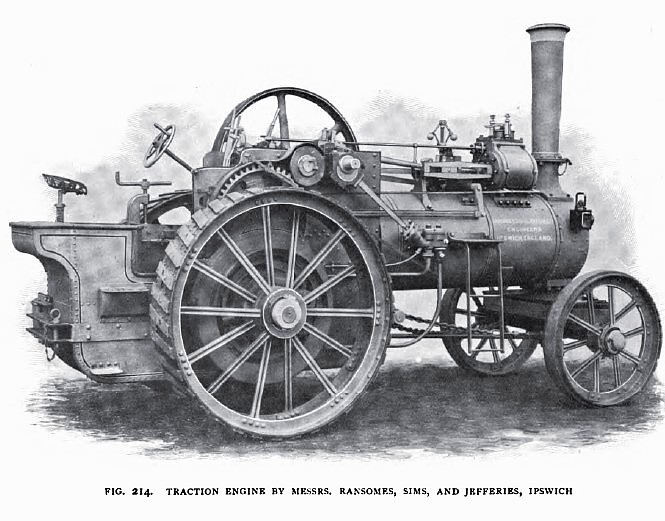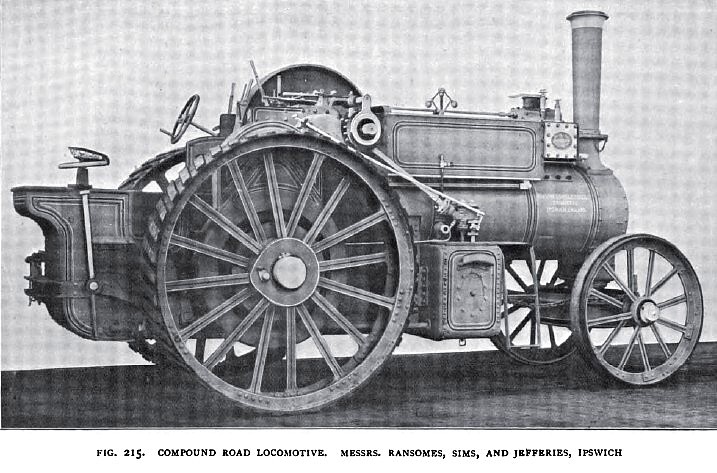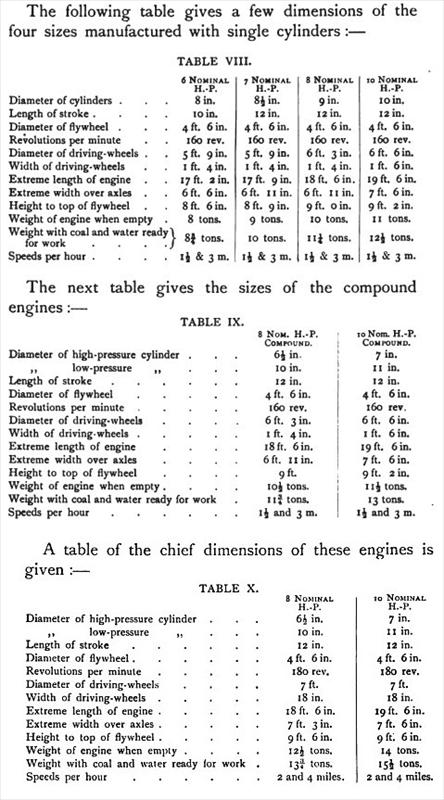|
Title: |
1904 Article-Ransomes, Sims & Jefferies, Ltd., Steam Traction & Road Engine |
|
Source: |
English and American Steam Carriages and Traction Engines 1904 pgs 348 & 353 |
|
Insert Date: |
8/19/2011 9:46:09 PM |
|
MESSRS. RANSOMES, SIMS, AND JEFFERIES — The agricultural locomotive illustrated by Fig. 214 is intended for driving a thrashing machine or for general hauling purposes on a farm, in fact for all the uses to which steam can be applied as a motive-power in farm work. From the illustration it will be seen that the engine is of the four-shaft type, so that any advantages of the inside gearing and the two countershafts are secured in this example. The engine is fitted with four slide-bars, with cast-iron slipper blocks. An outside feed-pump is provided, which can be started or stopped from the tender. Most of the details are of the usual form now adopted by all the leading makers. It may be remarked that this engine was designed a few years ago by the writer. The boiler is made entirely of steel, and is of the most approved locomotive design. It is of ample capacity, and of full strength for working continuously at 140 lbs. pressure per square inch, being tested by hydraulic pressure to 240 lbs. The longitudinal seams are double-riveted, and the edges of the plates planed. All riveting and flanging are done by hydraulic pressure. The fire-box is of special fire-box-quality steel, and is constructed to burn any description of coal, but if required for burning wood, shavings, or straw, it can be made of extra-large dimensions. The tops of the fire-box are stayed directly to the arch-plate, thus enabling the fire-box tops to be kept free from scale and sediment. The illustration, Fig. 215, represents a compound road locomotive fitted for continuous hauling purposes. It will be seen that the steam chests are placed outside, making the examination, adjustment, or repairs of the slide-valves or valve faces easily accessible. The fore tank is placed in the usual position beneath the pump, the pipes from which draw the feed and return into the tank the water that is not sent into the boiler. A water-lifter is mounted on the tank; the suction-hose may be carried on the bracket provided. The driving-wheels are of large diameter and of extra strength. The advantages of the compound engines are as follows. A saving of thirty per cent, in coal and water is effected; they can be started in any position of the cranks by means of an auxiliary valve which admits high-pressure steam to the low-pressure valve chest; they are less noisy than the single-cylinder engines; the cylinders are so proportioned that the work done is equally divided between them, thus ensuring steady running; the shocks on the crank-pins are less severe; the calls of the engine upon the boiler for steam are reduced, therefore the wear and tear of the fire-box and tubes are much diminished, and the cost of repairs reduced. The working parts generally are of extra strength for continuous hauling, this work being of a very severe nature that unless hauling engines are well made they will soon fail. |
|
 1904 Ransomes, Sims & Jefferies, Ltd., Steam Traction Engine
1904 Ransomes, Sims & Jefferies, Ltd., Steam Traction Engine
 1904 Ransomes, Sims & Jefferies, Ltd., Steam Road Locomotive
1904 Ransomes, Sims & Jefferies, Ltd., Steam Road Locomotive
 1904 Ransomes, Sims & Jefferies, Ltd., Table of Dimensions
1904 Ransomes, Sims & Jefferies, Ltd., Table of Dimensions
|
|